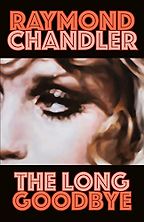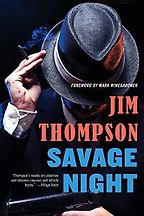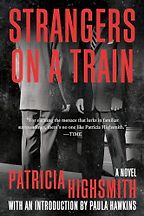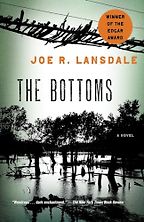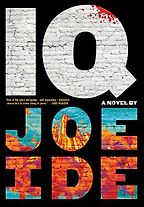Your debut feature was described as a Texas ‘neo-noir.’ Could you tell us how noir novels have influenced your filmmaking?
I’ve always had a real interest in that style and genre. My grandma was very into Agatha Christie. That’s not noir per se, but Agatha Christie was my gateway into mysteries, thrillers and pulp fiction. When we read the script for We Gotta Get Out of This Place, it reminded me of those kinds of books, and I went on a deep-dive into the world of Raymond Chandler and Dashiell Hammett—all those books that appear on every list of ‘the best crime novels’ or ‘the best noir books’. I went deep down that rabbit hole.
Since making We Gotta Get Out of This Place, noirs have continued to interest me. They influence most everything that I do, and every few months, I go back and re-read one of them.
I love the covers of those old dime-store novels. I can’t tell you how many books I have purchased purely because of the cover art—the font, the absurd, romantic images—some of them are really good, and others not so much, but it’s a fun way to discover something new.
Well, shall we talk about your first book recommendation? You’ve chosen Raymond Chandler’s The Long Goodbye, which is the sixth Philip Marlowe novel.
Yes, of course. Raymond Chandler is one of the godfathers of noir, and Philip Marlowe is probably the most quintessential character. The Long Goodbye was one of the first noir novels that I read. I love it when books really capture a setting and The Long Goodbye does that in spades.
Yes, it has a real behind-the-scenes feel. A seamy, smoky atmosphere.
Yes, everything is seedy. Everyone is drinking at all times. They wake up with a hangover and immediately smoke a cigarette. Something about that is very romantic to me, even though I don’t smoke—it captures another era, a certain time period in Los Angeles, post-World War II, where the city hasn’t been fully built yet and it’s rapidly changing.
With all of these books, I find that what most often sticks in my head is not necessarily the plot. It’s the settings they create. That’s what is so special about noir in general—these books capture and create these worlds, these dreamy environments. LA is probably the most quintessential noir setting, but some might take place in Scandinavia, or Texas, or other more elusive remote locations.
I often remember the setting more than who gets murdered or what mystery is uncovered—the plots can be relatively simple. The environments are my favourite thing, and this is one of the reasons I moved to Los Angeles.
Right. The purpose of the plot is merely to prompt the characters to move from location to location. Is that also true of your next choice? I’m less familiar with Jim Thompson’s 1953 novel Savage Night. It centres on a former hitman who has retired to Arizona for its dry desert air. That feels promising, in terms of atmosphere.
I think everyone knows the Dashiell Hammetts and the Raymond Chandlers. But Jim Thompson—I knew a few of his books, but I didn’t know his name so significantly. He was referenced several times in the screenplay for our movie, so he was the first writer I started to read. His books tend to be darker—like, actually dark.
“That’s what is so special about noir in general—these books capture and create these worlds, these dreamy environments”
With Raymond Chandler, the surface level is dark, but Jim Thompson’s books feel internally dark. In The Killer Inside of Me—you see it all from the perspective of the killer—a sociopath. Savage Night is another of his more famous books, and it plays with the character of the hitman. You see it from his perspective, and that’s something that Jim Thompson is able to do very well—step into the shoes of his characters, the anti-heroes, and show you these dark, complicated, and sometimes perverse minds—and he’s able to do it with a twisted sense of humour.
So his books are muddier and grimier than Raymond Chandler’s. I’m a big fan of Jim Thompson, and I think he’s really worth exploring for those that haven’t heard of him or read him before.
Is this revelation of the seedy underbelly the definitive element of noir?
I think so. Even if you just look at the movies—because, for me, I often come from the movie angle first—the play of light, the shadows, is the biggest thing in noir cinema. That’s the most transparent visual metaphor: What’s in the darkness? What’s in the shadows? So yes, that’s a quintessential part of noir. It doesn’t have to be seedy underbelly all of the time, but it does have to look at what’s lurking beneath the surface.
Right. Noir is a literary genre, but it’s also an aesthetic. Your third noir novel recommendation is another classic—Patricia Highsmith’s Strangers on a Train (1950).
The Talented Mr. Ripley gets all the love, but Strangers on a Train is the one I think everyone should focus on. It was also turned into a movie by Hitchcock in 1951, which is also phenomenal.
So, in Strangers on a Train, two strangers meet on a train and have a conversation about how their lives would be easier if—as one character says—someone killed his mom. The other is like: yeah, if somebody just killed my ex-wife, things would be so much easier for me. One of these men thinks it’s all a joke, a ridiculous conversation, but the other takes it seriously. Deadly serious.
It’s an idea that could be very goofy, and there have been movies that have played out the silly side of that storyline, like Horrible Bosses. But Patricia Highsmith can capture the internal workings of a dark character amazingly well, and create that kind of flow—plotting an element of impending doom—really, really well.
What I love is that she sets up quite a simple device, and then you are just waiting for terrible things to happen, for it all to unfold. She’s really good at creating that suspense. Strangers on a Train is a really special one—both the book and the movie, which have slightly different endings.
Your next recommendation is Joe Lansdale’s The Bottoms, which was published in 2000 but is set during the Great Depression. It won an Edgar Award when it was first published.
Joe Lansdale is an author that I came to later on, but he’s become one of my favourite writers. I love all of his books, and The Bottoms is one of my favourite books of all time.
A lot of his work is set in East Texas, which is bayou country. It’s marshy and very remote. The first season of True Detective is similar for anyone who has seen that. True Detective is set across the border in Louisiana, but it’s the same kind of world. And I think Lansdale does a really good job of playing with that atmosphere.
The Bottoms is about a boy in 1933 who finds the mutilated body of a black woman, dead, strung up to a tree—so a lot of the book is looking at race during that time period through the eyes of a young boy. So there’s a strong setting, and an almost mythological storyline. Because when you’re living in an environment that’s very remote, people create their own stories that get passed down for generations, and Lansdale does a good job of trying to understand the people who lived there during that period.
I can’t recommend The Bottoms more. Seeing it all from the boy’s viewpoint is a way of making it very shocking and confronting. I think when you talk about a subject like race, it can be trickier to navigate from an adult’s point of view, because an adult comes with a lot of baggage; I think it can be more eye opening to see the absurdities of how people are treated when you look at it from the perspective of a child witnessing these things for the first time, to look at it with fresh eyes.
Your final recommendation is Joe Ide’s IQ. The Guardian characterised it the character of IQ as “Sherlock Holmes in South Central Los Angeles.” How do you feel about that?
We had to come back to LA. All the other books we’ve looked at have been post-World War I or post-World War II. What’s so fun about IQ is that it uses a lot of the tropes of these older books that we’ve discussed and sets them in present day. It centres around Isaiah Quintana, also known as IQ: a high school dropout turned unlicensed private investigator in East Long Beach. Okay, so it’s not technically Los Angeles, but it’s pretty close and Joe Ide, the author, is from South Central LA, so I’m going to count it. Every once in a while, you see someone write a modern noir, but not in a setting like this. So it’s really refreshing and from a different perspective.
We featured one of its sequels, Hi Five, when it was shortlisted as one of the best thrillers of 2021 in the International Thriller Writers awards.
IQ is the first book in the series. I think there are six books so far and they’re all worth reading, but the first couple are really special. Isaiah takes it upon himself to help solve crimes in his community, crimes that are either too small for the police to worry about or crimes that take place in a community that the police don’t care enough to worry about. Isaiah only charges his clients what they can afford, and usually that is not a lot.
IQ is similar to Raymond Chandler in that there is some little crime that Isaiah gets involved with, and that leads to a much bigger, more intricate storyline.
We’ve spoken about the obvious cinematic qualities of noir books. You have mentioned a couple of adaptations already, but I feel like I should take the opportunity to ask for some more film noir recommendations.
Well, if you’ve never seen Chinatown, that’s the number one recommendation, without question. What’s funny is that, when you ask that question, all of the films that immediately come to mind are set in LA. It’s clear that Los Angeles is a draw, although it’s not true that noir can’t take place elsewhere.
So: LA Confidential, Chinatown, The Long Goodbye—the Robert Altman adaptation, which feels almost like you’re just wandering around Los Angeles in a dreamy haze, bouncing from place to place—plus the first movie by Rian Johnson, who does the Knives Out series now, which was called Brick. He took a present-day high school mystery and put in these fast-talking noir characters. That’s a really special one. He’s doing something fun with the genre that’s out of the ordinary. Brick was a big influence on us when we were crafting We Gotta Get Out of This Place.
Right, which is being re-released.
It came out almost ten years ago, and XYZ Films just picked it up and is re-releasing it. We Gotta Get Out of This Place stars Jeremy Allen White, who has had a lot of success with The Bear recently, and Mackenzie Davis, who’s in Halt and Catch Fire and the Terminator series. It’s really exciting—it’s rare to get a second life with these projects, and it’s wonderful that people will get to see the movie again.
Interview by Cal Flyn, Deputy Editor
August 8, 2024. Updated: August 12, 2024
Five Books aims to keep its book recommendations and interviews up to date. If you are the interviewee and would like to update your choice of books (or even just what you say about them) please email us at [email protected]
Five Books interviews are expensive to produce. If you've enjoyed this interview, please support us by donating a small amount.
